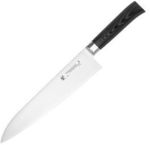The amount of effort that goes into making one of these is extraordinary. Individually hand forged.
3 Ply construction, similar to TOjiro DP.
Also i dont normally encourage the use of wheel sharpeners, but i acknowledge some people cant be bothered buying whetstones, and for $40 for a 3 stage wheel sharpener is a really good price. CAUTION: the third wheel is for single edged knives. DO NOT use this wheel for your normal chefs knives. They are ideal for the single sided sushi knives.
At these prices for the specs, its a STEAL! (yes pun intended)
Tamahagane San 27cm ~$87 SOLD OUT
Tamahagane San 18cm ~$80 SOLD OUT
Tamahagane 3 Stage Wheel Sharpener ~$40
Specs:
Construction: Blade: VG5 Core, SUS410
Handle: Laminated, silicon injected hardwood
Dimensions: (Check respective Lengths)
Features: Full tang
60:62 HRC
3 steel riveted handle
Gift boxed
Cleaning/care: Hand wash
Colour: Black Pakkawood handle
Origin: Japan
Warranty: Limited lifetime
27cm is an extremely long blade, usually these are more expensive than 21cm blades.
Edit: I have taken out references of "Damascus steel", because it is likely that kitchenware direct got it confused with Tamahagane's other lineup. The description on their website may be inaccurate.
After some research i found the most likely specs below. Thanks to the posted (below) for mentioning based on previous experience.
More info can be found here: http://www.nosawa.jp/housewares/en/lineup/san1.html
https://www.youtube.com/watch?v=7QNCgI8SLvc
Information about VG5 vs VG10
http://store.sointuusa.com/blog/vg5-steel-vs-vg10-steel/
#End-Grain Chopping boards: Peer Sorensen 48x35cm ~$55, 39x29~$40 +$9.90 Ship @KitchenwareDirect SOLD OUT
The appeal of end grain chopping boards is that they take the cross-sectional horizontal grain of the wood, which means its more forgiving to the edge of your knife.
The choice of wood and grain to use for your knife is just as important as the steel of the knife itself. Harder woods like bamboo will wear out the edge more quickly, softer woods like Japanese Cypress will help the sharpness of the knife edge be retained longer.Original eBay CGIFT20 deal
Peer Sorensen 48x35cm SOLD OUT
Peer Sorensen 39x29 Acacia End Grain SOLD OUT





Tamahagane Knife $39.95 Delivered @ Kitchenware Direct
35 layers Damascus Steel.
:)